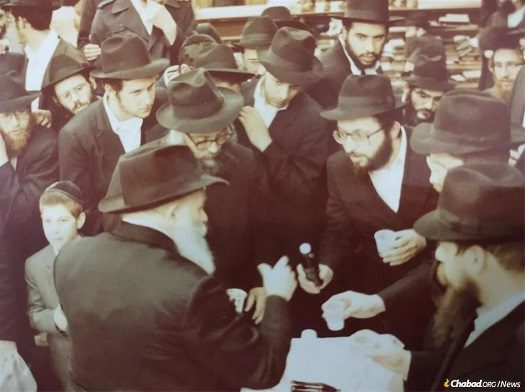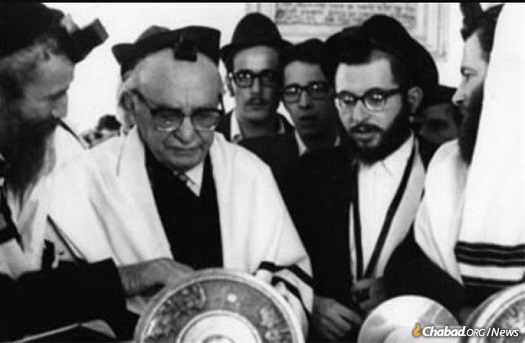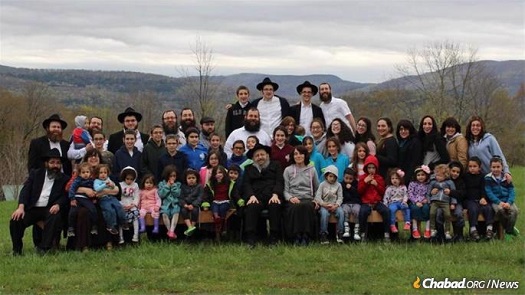
Obituary: Rabbi Sholom Jacobson, 74, Lifelong Publisher of Chassidic Texts
by Menachem Posner – chabad.org
Rabbi Sholom Jacobson was a man of many talents: he had a sharp mind, was a gifted artist, an inspiring orator, a prolific writer and deft organizer. Yet he used them all for one purpose, to further the vision of the Rebbe—Rabbi Menachem M. Schneerson, of righteous memory—to whom he was deeply connected. He passed away on July 27 (18 Av) at the age of 74.
Sholom Jacobson was born on 7 Adar, 5707 (1947), to Rabbi Simon and Fraida Yakobashvili (Jacobson), in a DP camp in Poking, Germany. His parents had recently escaped from the USSR, where Simon had been imprisoned in the Siberian gulag for the “crime” of strengthening Judaism and his subsequent refusal to implicate others.
The Jacobson family settled in France, while Simon spent the next few years traveling around Europe, bolstering Jewish life and rescuing Jewish children who had been placed in monasteries during the Holocaust.
Then, in 1952, they moved to Toronto, where Simon had been offered a rabbinic post. However, just half a year later, in the summer of 1953, he passed away. In 1955, Fraida passed away as well, leaving her seven-year-old son virtually alone (his two elder brothers, Gershon Ber and Betzalel, born before their father’s arrest and more than 10 years his senior, were already students at the Chabad-Lubavitch yeshivah in New York).
Sholom was taken in by R. Yankel and Taibel Lipskier, Russian Chassidim who lived near the Rebbe in New York whose generosity and kindness far outweighed their material wealth. Though the Lipskiers had nine children of their own, Sholom remained as a loved and cared-for member of their family until he was old enough to enter the yeshivah high school dormitory.
From his arrival in New York, his situation had been carefully monitored by the Rebbe, who showered him with special attention and whom he regarded as a father figure. He loved the Rebbe dearly and was dedicated to doing anything he could to actualize the Rebbe’s interests.
Publishing Transcripts of the Rebbe’s Talks
In 1967, with the encouragement of the legendary Chassid Rabbi Bentzion Shemtov, Jacobson threw himself into what was then a trailblazing effort to publish transcripts of the Rebbe’s talks and Chassidic essays.
In time, Jacobson’s efforts, as well as those of his colleagues, grew into a well-oiled machine, which churned out a dizzying array of publications, often with breathtaking speed and accuracy. At times he would spend days and nights on end, with astonishing dedication, working feverishly to meet deadlines requested by the Rebbe. In later years he worked on translating the Rebbe’s talks to English, with particular focus on his message of the imminent arrival of Mashiach.
Blessed with a strong memory and a gift for oration, he would often repeat the Rebbe’s talks for the benefit of those who had either not heard or not understood what the Rebbe had said.
In addition to his communal endeavors, he also wrote transcripts of the Rebbe’s discourses for his own personal use as early as 1965.
Just after his passing, his transcription of a discourse the Rebbe, titled Hashamayim Kis’i and originally delivered in 1968, was printed for the very first time. Until then it was among the several dozen discourses of the Rebbe for which no known transcript existed and therefore never printed.
Naturally artistic (he once witnessed a stabbing and sketched the three perpetrators from memory, thus facilitating their arrest), he used this talent for his beloved Rebbe as well. In advance of the Lag BaOmer parade of 1967, he designed the platform upon which the Rebbe stood, in later years, carefully picking colors and textures in order to bring out the majesty and grandeur of the scene. That set the tone for the rich velvet bunting that became standard in the years to come.
An Open Chassidic Home
In 1972 he was engaged to Faigle Springer of Kfar Chabad, Israel. Before the wedding, the Rebbe gave him a bottle of spirits and instructed him to act as his agent to deliver it to then-president of Israel, Zalman Shazar
The Rebbe further arranged to sponsor a surprise sheva brachot celebration for the couple as his personal recognition of the groom’s efforts to disseminate Chassidic teachings.
At the Rebbe’s wish, the Jacobsons founded an open home in Brooklyn, where he dedicated himself to publishing and disseminating the Rebbe’s teachings. Among their many guests were the students at Machon Chana-Women’s Institute for the Study of Judaism, where he taught and mentored for decades.
Long after graduating, they would return (often with families of their own) to enjoy the fresh food and timeless Torah teachings that were applied in real-time, that personified the Jacobson home.
He also served as a teacher and guide to the high school students at Educational Institute Oholei Torah, where his sensitivity to his students and rich knowledge of Chassidic teachings and tradition had a profound effect on his students, as it was to the many individuals who would join one of the many classes he gave regularly in local synagogues and private homes.
Printing Tanyas All Over the World
In 1978, the Rebbe issued a call to print the Tanya in as many cities as possible, wherever Jews lived. It was a wide-ranging campaign that would grow to encompass more than 7,000 locations, with new prints being added on a regular basis (for example, South Padre Island, Texas, just celebrated their own printing the other week).
The Rebbe issued numerous specific guidelines with regards to these printings, including the number of books to be printed in each place, that each printing be issued its unique edition number, and that the most accurate version of the Tanya be used.
An energetic and methodical publisher, it was only natural that Jacobson took the lead in the campaign, keeping careful count of the various editions and sending freshly printed Tanyas as well as regular reports to the Rebbe.
He remained actively involved in this endeavor for the rest of his life, in time, replacing printing plates with offset machinery with laser printers and PDF files.
He cared little for money or honor and would gladly teach wherever asked, including at Congregation Ahavas Moische, a nondescript synagogue which sits on what was long considered the edge of Jewish Crown Heights, where he served as spiritual guide and teacher for decades.
In addition to his wife, he is survived by his children, Rabbi Levi Jacobson (Toronto), Fraida Schusterman (Indianapolis, Ind.), Rabbi Simon Jacobson (Punta Gorda, Fla.), Doba Webb (Brooklyn), Chana Steinmetz (Brooklyn), Chaim Moshe Jacobson (Brooklyn), Rabbi Mendel Jacobson (Atlanta), Shmuel Jacobson (Brooklyn), and many grandchildren.
This article has been posted with permission from chabad.org

















